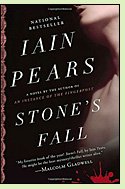Stone's Fall
by Iain Pears
Reviewed by Margaret Tomlinson

Only superficially is Stone's Fall a mystery novel. With the heft and depth of a serious literary novel and characters at once engagingly sympathetic and disturbingly imperfect, it has a richness that far surpasses the genre.
In 1909, the widow of a wealthy manufacturer hires a second-rate journalist to investigate a clause in her husband's will. John Stone, Lord Ravenscliff, has recently died, falling from a window in his second-floor office that he typically avoided because of his fear of heights. It is not, however, the suspicious nature of his death that brings Lady Ravenscliff to hire Braddock, but the substantial bequest to her late husband's child, whose existence is a complete surprise to her. She asks Braddock to find the child so the bequest can be accomplished and the estate settled.
Unskilled in examining financial records, Braddock enlists the help of a banker, whose fascination with what he finds in Stone's accounts makes them similarly fascinating even to a reader whose eyes, like Braddock's, tend to glaze over when faced with columns of numbers. The story later reaches back to an 1890 banking crisis and then a more personal crisis in 1867 Venice. Pears began this prescient novel a couple of years before the 2008 recession and published it in 2009. Since then, with tensions rising around the world and the economic recovery delivering most of its gains to multi-millionaires while middle- and working-class incomes languish, it has become all the more pertinent.
A list of the novel's many characters might have helped readers keep track of some who move in and out of the story, but the major characters are so memorably drawn this is not a serious hindrance. The intricate plot is full of twists and turns. Readers who like novels encompassing both the gripping suspense of genre fiction and the thematic depth and complexity of literary fiction will especially appreciate Stone's Fall. (2009; 596 pages)
More about Stone's Fall at Powell's Books or Amazon.comOther novels about industrialists:
Shirley by Charlotte Brontë (1849), about a ruthless mill owner in nineteenth-century Yorkshire and the orphaned heiress he wishes to marry for her money. More info
The Silence by J. Sydney Jones (2011), a mystery novel about a Jewish lawyer's investigation into the suicide of a Vienna councilman, possibly connected to the disappearance of the eldest son of wealthy industrialist Karl Wittgenstein; #3 in the Karl Werthen series. More info
The Clouded Hills by Brenda Jagger (1980; also titled Verity), about a young textile mills heiress in Yorkshire and her arranged marriage to her handsome cousin, a ruthless businessman, during the upheavals of the Industrial Revolution; #1 in the Barforth trilogy. More info
Nonfiction about arms manufacturing:
Shadows of War: Violence, Power & International Profiteering in the Twenty-First Century by Carolyn Nordstrom (2004). More info
The Profiteers: Bechtel and the Men Who Built the World by Sally Denton (2016). More info
The Devil's Device: Robert Whitehead and the History of the Torpedo by Edwyn Gray (1991). More info
Online:
Merchants of Death: The International Traffic in Arms at the Origins website, published by the History Departments at The Ohio State University and Miami University.
Back to Novels of Nineteenth-Century Europe
Back to Directory of Book Reviews